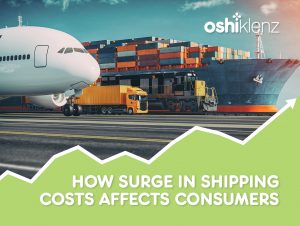
How Surge in Shipping Costs Affects Consumers. The economy of countries all over the world is just starting to recover. And they’re already being threatened by high freight rates. There has been a more or less 900% increase in sea freight rates over the last 2 years.
The price increase put pressure on importers and exporters which they then pass unto consumers. This article will discuss how and why this surge took place and its direct effect on consumers.
Demand for goods surged in the second half of 2020 and into 2021, consumers. Spent their money on goods rather than services during pandemic lockdowns and restrictions.
Working from home, online shopping, and increased computer sales all placed unprecedented demand on supply chains. This large swing in containerized trade flows was met with supply-side capacity constraints. Including container shortages, labour shortages, continued on and off Covid-19 restrictions, and congestion of ports.
For example, transporting a 40-foot steel container of cargo by sea from Shanghai to Rotterdam. Now costs a record $10,522, a shopping 547% higher than the seasonal average over the last five years.
With upwards of 80% of all goods traded transported by sea, freight-cost surges are threatening to boost the price of everything from toys, furniture, and car parts to coffee, sugar, and anchovies.
Often dismissed as having an insignificant impact on inflation because they were a tiny part of the overall expense, rising shipping costs are now forcing economists to pay them more attention.
But how does it directly affects consumers?
At the retail level, vendors are faced with three choices: halt trade, raise prices or absorb the cost to pass it on later. Unfortunately, all of these would effectively mean more expensive goods for end consumers.
Additionally, prices for consumers are rising in other ways, too. For instance, anchovies from Peru have largely stopped being imported into Europe because with the higher freight costs they are not competitive compared to what’s available locally.
Freight costs are more painful for companies that move clunky, low-value items like toys and furniture. Not to mention if they are bulky products it means you can’t get very many in the container and that will have a significant impact on the landed price of the goods.
As it is, companies are desperately trying to work around the higher costs. Some have stopped exporting to certain locations while others are looking for goods or raw materials from nearer locations.
If you’re a business owner based in Australia who runs wellness spas, restaurants, bars, gyms, dental clinics et.al., you surely need a constant supply of hot towels and wet wipes. We at Oshiklenz can offer competitive packages for you.
We also offer wholesale pricing based on volume orders.
If you’re interested to order our products for your business or you want to be a distributor, you can call us at (+61) 2 9533 2211 for inquiries and a representative will be glad to assist you with your needs. You may also send us an email at info@oshiklenz.com.au.
